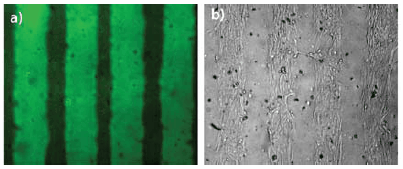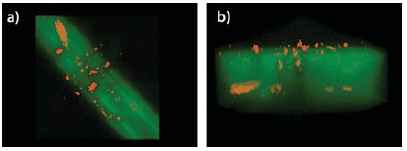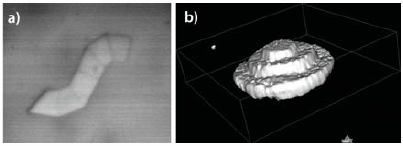Patterning PEG-based Hydrogels for Complexity
Most biomaterial scaffolds developed for tissue engineering applications are relatively homogeneous and lack the complexity and organization of the in vivo cellular microenvironment. While these homogeneous scaffolds have enabled remarkable progress in understanding cell responses to their microenvironment, elucidating the dynamic relationship between biomaterial properties and their influence on biological function may require more spatially and temporally complex scaffolds. Thus, various patterning methods have been developed to permit control over the presentation of biochemical and biomechanical cues in both space and time. To explore the cell responses to dynamic alterations in 3D matrix properties, scaffold modifications must be performed in a manner compatible with the maintenance of cell viability. Therefore, many of the patterning techniques applied to silicon and glass substrates cannot be readily transitioned to these applications. In this article, we will discuss the benefits and limitations of several 2D and 3D scaffold patterning techniques that can be applied in the presence of cells. Although these methods will be discussed in the context of poly(ethylene glycol) (PEG)-based hydrogels, they can technically be applied to any optically transparent, photoactive substrate.
Hydrogels are a class of biomaterial scaffolds that have been widely used in complex device fabrication, drug release, and tissue engineering. PEG-based hydrogels, in particular, have proven extremely versatile for tissue engineering applications. PEG is FDA approved for a variety of applications and exhibits high biocompatibility and little or no immunogenicity. In addition, PEG-based hydrogels display tunable mechanical properties in the range appropriate to soft tissue regeneration. Importantly for patterning applications, PEG-based hydrogels are intrinsically resistant to protein adsorption and cell adhesion, thus providing biological “blank slates” upon which desired biofunctionality can be built. 1To generate PEG hydrogels, individual PEG chains that have been functionalized with two or more crosslinkable groups, such as acrylates, are dissolved in aqueous solution, mixed with appropriate photoinitiator (e.g., 2,2 dimethoxy-2-phenyl acetophenone), and exposed to UV or visible light. 2,3 The acrylate groups cross-link via free radical polymerization to form an insoluble hydrogel network. These polymerization processes require between 1 and 10 minutes of illumination, depending on the photoinitiator and the intensity of the light source, and can be conducted under mild conditions that allow maintenance of cell viability. Although the polymerization process is rapid, its efficient quenching by oxygen and other free radicals is believed to maintain the spatial localization of the light-induced polymerization, which is essential to high fidelity pattern formation. Patterning of the PEG-based hydrogels can be broadly divided into two approaches, one focusing on fabricating hydrogel networks of complex geometries and another focused on spatially and temporally modifying existing (pre-formed), cell-laden hydrogel structures.4-16Development of the latter approach, which will be the focus of this review, is particularly critical to understanding the spatial and temporal role of biomechanical versus biochemical signals in cell function as well as in complex tissue regeneration. In the following discussion, the term “2D patterning” will refer to the formation of patterns that vary in x-y directions but are uniform in the z direction, whereas the term “3D patterning” will refer to the generation of patterns that can vary in x, y, and z. In other words, these terminologies refer to the dimensionality of the spatial variations of the pattern rather than to the dimensionality of the patterned substrates.
Two-dimensional Patterning Methods
Transparency-based photolithography is one approach for creating 2D biochemical and biomechanical patterns within existing hydrogel structures. In one embodiment of this strategy, a hydrogel is prepared from PEG-diacrylate (PEGDA, Prod. Nos. 701971, 701963) in such a manner as to leave sufficient free acrylate groups available for subsequent reactions.10 The acrylated moieties to be patterned are then applied to the surfaces of these “incompletely” polymerized gels and a transparency photomask is placed in direct contact with the hydrogel surface. Following hydrogel illumination through the photomask, monoacrylated materials are covalently immobilized to the surface of the hydrogel in areas corresponding to light-permissive regions of the mask. Patterning of monoacrylated, cell-adhesive factors permits definition of specific regions for cell-material interactions while the unpatterned regions remain bioinert (Figure 1). Multiple cell adhesive peptides can be readily patterned onto the hydrogel surface by sequential application of this method.10,15

Figure 1. Transparency-based patterning. (a) Pattern of fluorescently labeled, monoacrylate-derivatized cell adhesion peptide Arg-Gly-Asp-Ser (RGDS) formed on the surface of an existing PEGDA hydrogel network using transparency-based photolithography. (b) Associated human dermal fibroblast surface adhesion demonstrating that unpatterned regions remain bioinert.
As demonstrated by West and coworkers, if the acrylated species are allowed to diffuse into the hydrogel network prior to illumination, the resulting pattern will extend through the full thickness of the gel and can be used to control cell behavior internal to the hydrogel (Figure 2).11 Furthermore, if the entities to be patterned are functionalized with two or more acrylate groups, regional alterations in hydrogel biomechanical properties can be achieved.11

Figure 2. Cell migration confined to channels patterned using transparency-based photolithography with monoacrylate-derivatized, fluorescently-labeled RGDS. These patterned channels were created within a pre-formed collagenase-degradable PEGDA hydrogel. (a) A top view of a 3D OsiriX volume rendering of a confocal image series (zstack) of the patterned hydrogels (acrylate-derivatized RGDS (green) and HT-1080 cell clusters (red-orange)). (b) A side view of a 3D OsiriX volume rendering of a confocal image series (z-stack) of the patterned hydrogels (acrylate-derivatized RGDS (green) and HT-1080 cell clusters (red-orange)). The apparent unevenness in RGDS intensity observed in (b) is primarily due, not to actual unevenness in RGDS patterning intensity, but to imaging artifacts.
In contrast to methods based on physical photomasks, the laser scanning capability of standard confocal microscopes can be used to generate 2D hydrogel surface patterns.9 As in the method for transparency-based hydrogel patterning, acrylated species are applied to the surface of pre-formed, but incompletely polymerized PEGDA hydrogels. Computer control of the scanning lasers and of the laser shutter results in a so-called “virtual mask” in which laser light is applied only to desired regions of the hydrogel surface. As established by West and coworkers, the levels of acrylated species conjugated to the hydrogel surface can be spatially controlled by user adjustment of laser intensity or scanning speed, allowing for complex 2D concentration gradients to be formed (Figure 3a).9 This level of spatial control over irradiation exposure is not readily achieved using conventional photolithographic masks. By incorporating intermediate wash steps between sequential irradiation cycles, multiple bioactive peptides can be patterned onto the hydrogel surface.9 In addition, uniform cross-section patterns extending through scaffolds of moderate thickness can be created using a confined laser beam rather than a focused laser beam.5

Figure 3. Standard laser scanning lithography and two-photon laser scanning lithography. (a) A gradient pattern of fluorescently labeled, monoacrylate-derivatized cell adhesion peptide RGDS formed of the surface of an existing PEGDA hydrogel network using the “virtual mask” capability of standard confocal microscopes. (b) A side view of a 3D OsiriX volume rendering of a confocal image series (z-stack) of a hydrogel patterned with fluorescently labeled, acrylate-derivatized RGDS (white) using a confocal microscope equipped with a two photon laser.
Three-dimensional Patterning Methods
The above-described methods are limited to the creation of vertically uniform patterns. To program the spatial complexity mimetic of native tissue into pre-formed hydrogels, researchers have turned to two photon-based patterning. The phenomenon of two-photon absorption has enabled the development of 3D fluorescence imaging and 3D lithographic microfabrication. Both of these applications take advantage of the fact that, by tightly focusing an excitation beam, the region of two photon adsorption can be confined to a focal volume roughly half the excitation wavelength in dimension. Any subsequent process, such as a photoinitiated, radical-based polymerization, is also localized to this small volume, assuming the time-scale of radical diffusion is large compared to the radical half-life. Thus, by specifying the location of the focal point of a two-photon laser beam, regions of photo-induced conjugation can be precisely dictated. This is in contrast to “standard” lasers in which photo-induced conjugation can occur outside the focal plane. Multiphoton laser modules are now available for most commercial confocal microscopes, allowing the laser scanning and shuttering capacity associated with these instruments to be readily applied to two-photon based patterning.
To create 3D patterns within existing hydrogel networks, incompletely polymerized PEGDA hydrogels are once again prepared and acrylated moieties are allowed to diffuse into the gel network, after which the hydrogel is placed on the confocal microscope stage and two-photon laser scanning is initiated. By varying the irradiation exposure time or beam intensity during the two photon patterning cycle, the levels of modification can be spatially tailored.11,16 Following polymerization, residual precursors are allowed to diffuse out of the hydrogel to reveal a heterogeneously-distributed patterned molecule (Figure 3b).11
Extended Chemistries
The above-described methods for 2D and 3D PEGDA hydrogel patterning rely on the same chemistry to both generate the PEG hydrogel and to conjugate various species to the gel networks. However, in this strategy, the patterning process itself further alters the initial gel structure, and the extent of network modification is limited by the availability of unreacted acrylate groups. Furthermore, although desired bioactive moieties can be added on demand, these chemistries do not enable ready removal of bioactive signals. To address these limitations, Anseth and co-workers have developed alternative chemistries that permit the synthesis of well-defined cross-linked hydrogels in which the physical and chemical properties of hydrogel are independently controlled.12-14 Essentially these strategies involve exploiting “orthogonal chemistries,” where one chemistry is used to generate the hydrogel network and a second chemistry is used to pattern in bioactive factors. Furthermore, the introduction of photolabile links within the hydrogel networks has enabled the removal of added bioactive signals at desired time points.14 Combined, the above-described 2D and 3D patterning methods enable the controlled investigation of the dynamic relationship between biomaterial properties and their influence on biological function. Advances in our understanding of cell behavior which result from studies using these patterned scaffold systems will enable intelligent design of scaffold properties for regenerative medicine applications.
Acknowledgments
Dr. Hahn would like to thank Dr. Jennifer West for providing images of cell migration in transparency-patterned gels (Figure 2) as well as images or renderings of confocal laser scanning patterns and twophoton laser scanning patterns (Figure 3).
Materials
References
如要继续阅读,请登录或创建帐户。
暂无帐户?